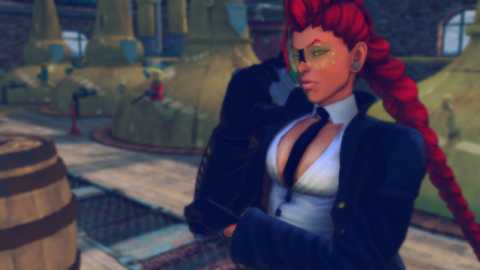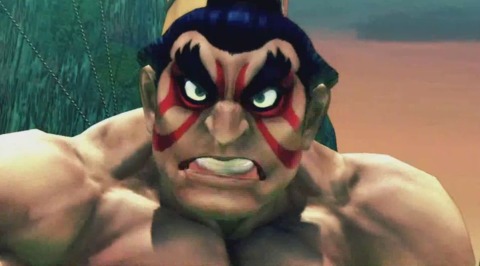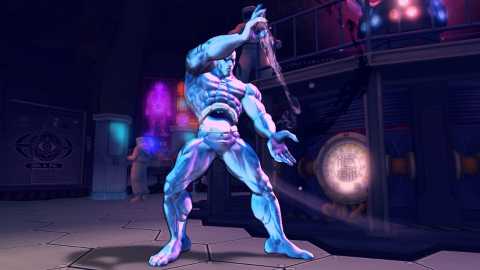
Street Fighter IV gets back to basics in a lot of ways. If you played Street Fighter II Turbo: Hyper Fighting to death and then sort of drifted away from the genre, you'll probably be able to jump right back in after a little refresher course. The original 12 characters from Street Fighter II are present, and there are 25 characters in all. The rest of the roster pulls in a pair from Super Street Fighter II, a few from the Alpha games, and a collection of new fighters. From a gameplay perspective, the new characters fit in just fine. From a look-and-feel angle, though, guys like El Fuerte, the lucha libre chef, feel a little out of place. Likewise with the big, bobbling belly with appendages that is Rufus. But while they may look and act like comedy characters, they aren't total jokes when you're at the controls. Also not a joke? Gouken, a fighter who has appeared in the Street Fighter storyline before, but makes his first appearance as a playable fighter here. As Akuma's brother, he's the good guy to Akuma's raging demon badness. While you probably won't enjoy controlling every last fighter in the lineup (I've never been much for Dhalsim and I don't much care for Gen, either), there are enough different characters here to ensure that you've got a main selection and a couple of backups.

So what do you do if you can't quite figure out when and where to employ those techniques? Or, to be more direct, what do you do when everything I said in the previous paragraph sounds like meaningless jibber-jabber? Ideally, that's what the game's trial mode would teach you, as its main focus is to help people get better at the game. But it doesn't teach you anything about theory, the hows and whys of the way the game functions, or even basic stuff about when you can safely jump in on someone and when you shouldn't. Instead, the trial mode gives you a list of moves to perform, starting with the absolute basics, moving on to simple cancels, and eventually getting into some lengthy, difficult combos. If you already understand the basics, this mode will let you pick up some deadly combos. But it doesn't even meet you halfway and let you view the moves being performed before you attempt them, leaving things like working out the timing of the combo to you. If you already know how to play the game, it won't be an issue. But if you already know how to play the game, all you'll take away from it are a bunch of new combos that, depending on your skill level, you may or may not be able to actually complete. It's sort of frustrating, because if this mode were more fleshed out, it might help complete neophytes understand the core concepts behind canceling from one move into another.

While fighting the game's AI can make for a fine time, the very nature of fighting games all but requires you to play against a human opponent. While you can certainly do that locally, the real draw of Street Fighter IV is its online play. As with anything played over a network, there are a lot of different factors that can hamper the game's ability to play smoothly, but other than a couple of typical, minor hitches, the online seems to work fantastically. For the most part, it's the typical ranked/unranked setup, but there's also a way to configure your arcade mode games to allow players to butt in with fight requests, which is a cool function that sort of replicates the arcade experience. A championship mode patch added a sort of ladder-like tournament setup to the online mode in the console releases, and this mode shipped by default in the PC version of the game. It's interesting because it doesn't require you to assemble a full tournament bracket before starting to fight. It just sort of assembles the brackets on the fly as you partake in tournament matches.
Online, you can present yourself via a title and an icon. You unlock additional titles and icons by performing certain tasks. So, for completing a trial stage with Sagat, you might earn the "Password is 'Tiger'" title. There are 16 pages of different titles to get, and once you start playing online, you seem to just start racking them up. Same goes for icons, which range from little leaves that denote some basic level of experience to a baby chick, to a picture of a joystick, and so on. The game doesn't really specify how these items are unlocked, so people on the hunt for all of them will have a lot of work ahead of them.

The audio portion of Street Fighter IV might be a bit off-putting for some players at first, but you're given enough options to straighten things out to your liking. The game's main menu and intro is set to music that sounds like some kind of boy band nightmare. The worst part is that "Indestructible" is incredibly catchy, and it's been sort of half-stuck in my head for around 10 days or so. It's also worth mentioning that the character voices have all been recorded in English as well as Japanese. Now that doesn't mean that you're going to hear Ryu shouting "dragon punch" instead of "shoryuken," but the between-fight banter is spoken in English by default. Also, all of the fight voices have been recorded twice, so Ryu will say "shoryuken" differently depending on which voice actor is on the mic. After completing the game once, you can set any of the fighters to Japanese on an individual basis, so if you think it's wrong that Akuma's voice sounds a lot like Blanka's, you can opt for his Japanese track. I initially assumed I'd despise all the English acting and snob out like a purist, but most of it's just fine.
My only real complaint about Street Fighter IV is that the trial mode represents a missed opportunity to help brand-new players get into the game, and perhaps the genre, as well. I only know what I know about Street Fighter because I've been playing and watching it since the early 1990s. Will it take 20 years for new players to acquire the same bits of knowledge that I have? The good news is that Street Fighter IV is a game so great that playing it for that long doesn't immediately sound out of the question.